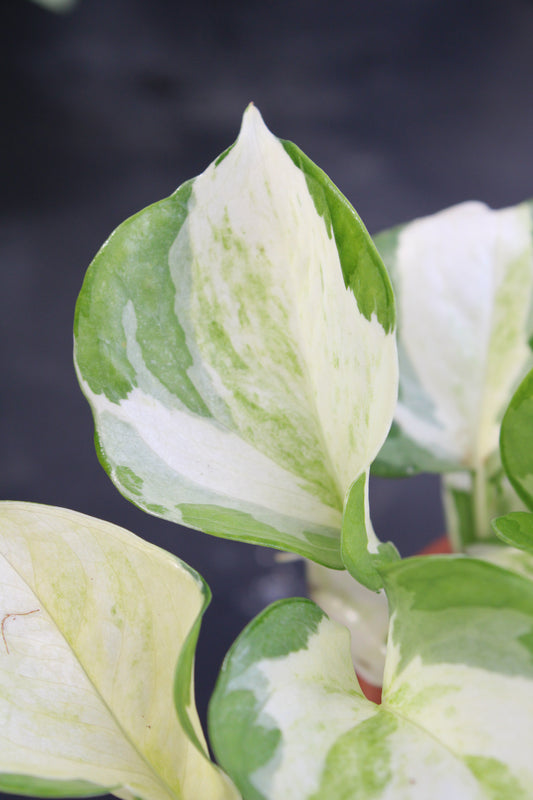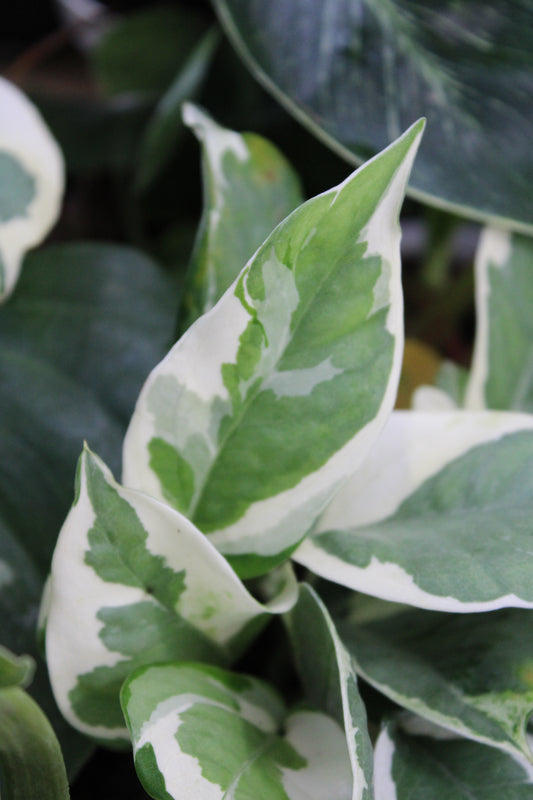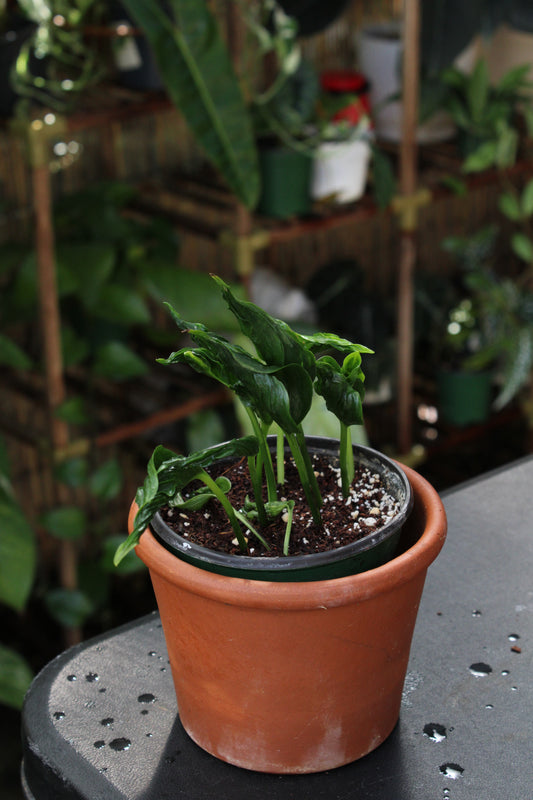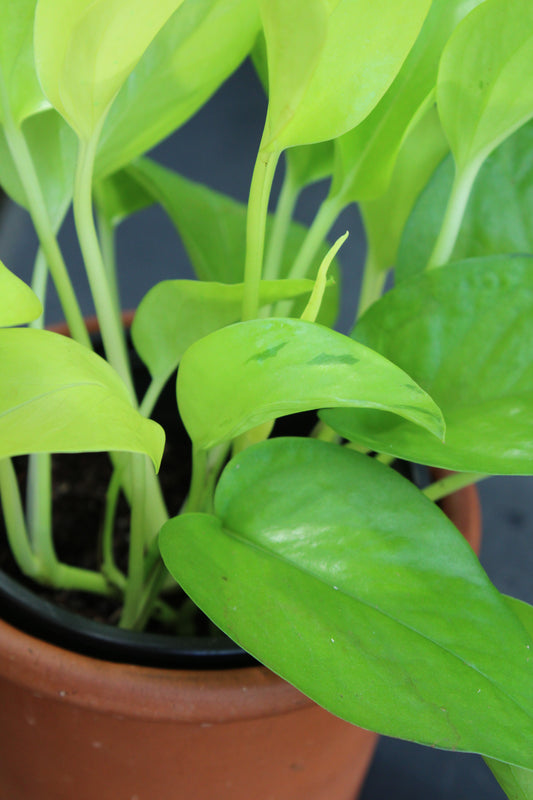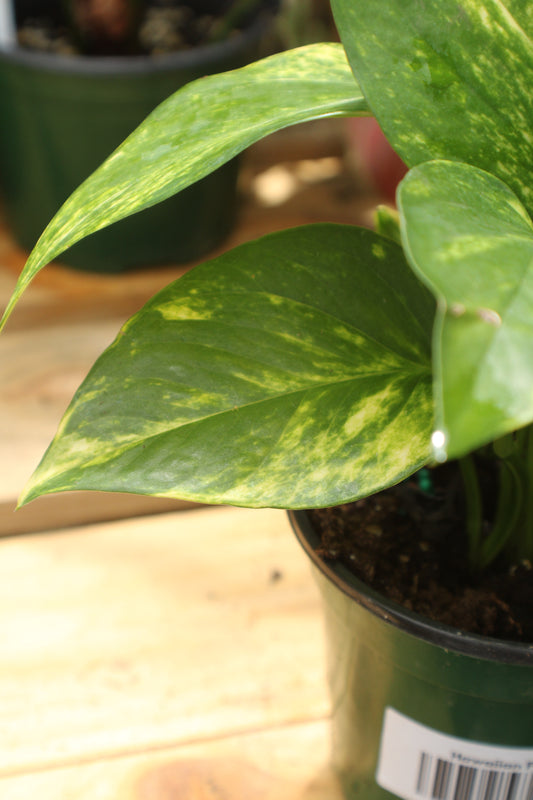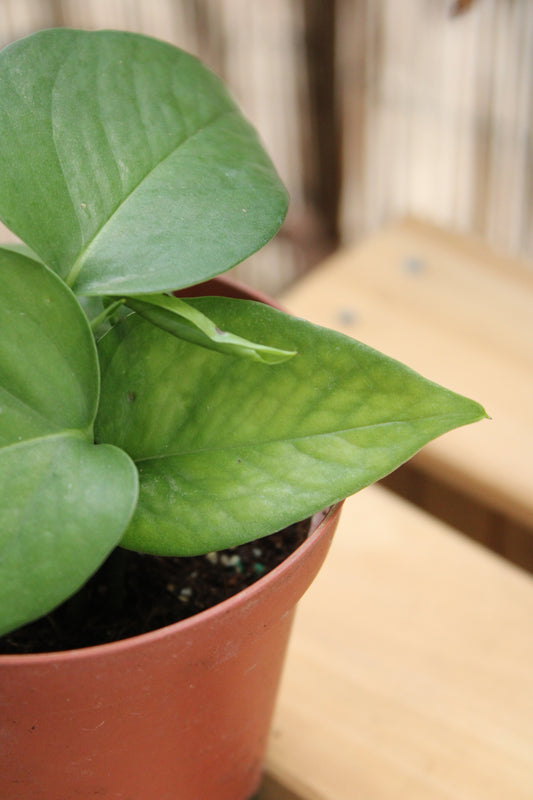
Pothos Care
Pothos are a popular and easy-to-care-for houseplant. It has air-purifying qualities that contribute to better air quality, making it the perfect addition to your lovely space.
Collapsible content

Cebu Blue Pothos
LIGHT
Your pothos can survive in low light, but grows faster in bright indirect light. It does not tolerate direct sunlight, which will burn the leaves.
WATER
Water it when it is 50% dry or when the leaves are fallen and the soil is completely dry. Too much water will cause death. Excessive watering causes root rot and yellow leaves.
HUMIDITY
Pothos grow well in low humidity, but high humidity between 40% and 60% will allow the plant to thrive and grow. Low humidity will cause brown or yellow tips.
TEMPERATURE
Your pothos prefers temperatures of 65 to 85 degrees.
FOOD
It likes to be fed monthly or every other month with a general houseplant fertilizer.
TOXICITY
Pothos are toxic to pets and humans. Digestion of this plant will cause burning in the mouth, throat, lips and tongue.
Additional Tips*
This plant will benefit from a moss support or a coconut fiber support. Any type of support that can contribute to its growth pattern will help this plant reach maturity.
When this plant reaches maturity it tends to fenestrate.
This plant becomes semi dormant in winter so it will loose some leaves. Dont worry about it; it will bounce back on spring.
Use a well-draining substrate, such as a mixture of coconut fiber, perlite, pine bark, and activated charcoal. This ensures good aeration and prevents excess humidity.
Hawaiian Pothos
LIGHT
Your Pothos can survive low light, but it grows faster in bright indirect light. It will not tolerate direct sunlight, it will burn the leaves.
WATER
Your Hawaiian Pothos needs water when its 50% dry or when leaves a droopy and the soil is completely dry. Too much water will lead to death. Overwatering causes root rot, yellow leaves. Adjust watering frequency in low light conditions
HUMIDITY
Pothos do well in low humidity, but high humidity between 40% and 60% will make the plant thrive and grow. Low humidity will cause brown or yellow tips.
TEMPERATURE
Hawaiian Pothos prefer temperatures between 65-85 degrees
FOOD
Your pothos like to be fed monthly or every other month with some general indoor plant fertilizer.
TOXICITY
Pothos are toxic to pets and humans. Digesting this plant will cause burning in mouth throat, lips and tongue.
Additional Tips*
This plant will benefit from a moss support or a coconut fiber support. Any type of support that can contribute to its growth pattern will help this plant reach maturity.
When this plant reaches maturity it tends to fenestrate.
Use a well-draining substrate, such as a mixture of coconut fiber, perlite, pine bark, and activated charcoal. This ensures good aeration and prevents excess humidity.
Jade Pothos
LIGHT
Your pothos can survive in low light, but grows faster in bright indirect light. It does not tolerate direct sunlight, which will burn the leaves.
WATER
Water it when it is 50% dry or when the leaves are fallen and the soil is completely dry. Too much water will cause death. Excessive watering causes root rot and yellow leaves.
HUMIDITY
Pothos grow well in low humidity, but high humidity between 40% and 60% will allow the plant to thrive and grow. Low humidity will cause brown or yellow tips.
TEMPERATURE
Your pothos prefers temperatures of 65 to 85 degrees.
FOOD
It likes to be fed monthly or every other month with a general houseplant fertilizer.
TOXICITY
Pothos are toxic to pets and humans. Digestion of this plant will cause burning in the mouth, throat, lips and tongue.
Additional Tips*
This plant will benefit from a moss support or a coconut fiber support. Any type of support that can contribute to its growth pattern will help this plant reach maturity.
When this plant reaches maturity it tends to fenestrate.
Use a well-draining substrate, such as a mixture of coconut fiber, perlite, pine bark, and activated charcoal. This ensures good aeration and prevents excess humidity.
Jessenia Pothos
LIGHT
Your Pothos can survive low light, but it grows faster in bright indirect light. It will not tolerate direct sunlight, it will burn the leaves.
WATER
Your Jessenia Pothos needs water when its 50% dry or when leaves a droopy and the soil is completely dry. Too much water will lead to death. Overwatering causes root rot, yellow leaves. Adjust watering frequency in low light conditions
HUMIDITY
Pothos do well in low humidity, but high humidity between 40% and 60% will make the plant thrive and grow. Low humidity will cause brown or yellow tips.
TEMPERATURE
Jessenia Pothos prefer temperatures between 65-85 degrees
FOOD
Your pothos like to be fed monthly or every other month with some general indoor plant fertilizer.
TOXICITY
Pothos are toxic to pets and humans. Digesting this plant will cause burning in mouth throat, lips and tongue.
Additional Tips*
This plant will benefit from a moss support or a coconut fiber support. Any type of support that can contribute to its growth pattern will help this plant reach maturity.
When this plant reaches maturity it tends to fenestrate.
Use a well-draining substrate, such as a mixture of coconut fiber, perlite, pine bark, and activated charcoal. This ensures good aeration and prevents excess humidity.
Manjula Pothos
LIGHT
Your pothos prefers bright indirect light, but will tolerate medium to low light. As light increases so will its variegation, low light can make them revert to green. It will not tolerate direct sunlight, it will burn the leaves.
WATER
Water when its 50% dry or when leaves a droopy and the soil is completely dry. Too much water will lead to death. Overwatering causes root rot, yellow leaves.
HUMIDITY
Pothos do well in low humidity, but high humidity between 40% and 60% will make the plant thrive and grow. Low humidity will cause brown or yellow tips.
TEMPERATURE
Your Manjula Pothos prefer temperatures of 65-85 degrees.
FOOD
It likes to be fed monthly or every other month with some general indoor plant fertilizer.
TOXICITY
Pothos are toxic to pets and humans. Digesting this plant will cause burning in mouth throat, lips and tongue.
Additional Tips*
This plant will benefit from a moss support or a coconut fiber support. Any type of support that can contribute to its growth pattern will help this plant reach maturity.
When this plant reaches maturity it has to fenestrate.
Use a well-draining substrate, such as a mixture of coconut fiber, perlite, pine bark, and activated charcoal. This ensures good aeration and prevents excess humidity.
Marble Epiprenum Pinnatum
LIGHT
Your Epiprenum prefers bright indirect light, but will tolerate medium to low light. As the light increases, so will its variegation; low light can cause them to turn green. It does not tolerate direct sunlight, which will burn the leaves.
WATER
Water it when it is 50% dry or when the leaves are fallen and the soil is completely dry. Too much water will cause death. Excessive watering causes root rot and yellow leaves.
HUMIDITY
Epiprenums grow well in low humidity, but high humidity between 40% and 60% will allow the plant to thrive and grow. Low humidity will cause brown or yellow tips.
TEMPERATURE
Your Epiprenum prefers temperatures of 65 to 85 degrees.
FOOD
It likes to be fed monthly or every other month with a general houseplant fertilizer.
TOXICITY
Epiprenums are toxic to pets and humans. Digestion of this plant will cause burning in the mouth, throat, lips and tongue.
Additional Tips*
This plant will benefit from a moss support or a coconut fiber support. Any type of support that can contribute to its growth pattern will help this plant reach maturity.
Use a well-draining substrate, such as a mixture of coconut fiber, perlite, pine bark, and activated charcoal. This ensures good aeration and prevents excess humidity.
When this plant reaches maturity it tends to fenestrate.
This plant becomes semi dormant in winter so it will loose some leaves. Dont worry about it; it will bounce back on spring.
Marble Queen Pothos
LIGHT
Your Pothos can survive low light, but it grows faster in bright indirect light. It will not tolerate direct sunlight, it will burn the leaves.
WATER
Your Marble Queen Pothos needs water when its 50% dry or when leaves a droopy and the soil is completely dry. Too much water will lead to death. Overwatering causes root rot, yellow leaves. Adjust watering frequency in low light conditions
HUMIDITY
Pothos do well in low humidity, but high humidity between 40% and 60% will make the plant thrive and grow. Low humidity will cause brown or yellow tips.
TEMPERATURE
Marble Queen Pothos prefer temperatures between 65-85 degrees
FOOD
Your pothos like to be fed monthly or every other month with some general indoor plant fertilizer.
TOXICITY
Pothos are toxic to pets and humans. Digesting this plant will cause burning in mouth throat, lips and tongue.
Additional Tips*
This plant will benefit from a moss support or a coconut fiber support. Any type of support that can contribute to its growth pattern will help this plant reach maturity.
When this plant reaches maturity it tends to fenestrate.
Use a well-draining substrate, such as a mixture of coconut fiber, perlite, pine bark, and activated charcoal. This ensures good aeration and prevents excess humidity.
Neon Pothos
LIGHT
Your Pothos can survive low light, but it grows faster in bright indirect light. It will not tolerate direct sunlight, it will burn the leaves.
WATER
Your Neon Pothos needs water when its 50% dry or when leaves a droopy and the soil is completely dry. Too much water will lead to death. Overwatering causes root rot, yellow leaves. Adjust watering frequency in low light conditions
HUMIDITY
Pothos do well in low humidity, but high humidity between 40% and 60% will make the plant thrive and grow. Low humidity will cause brown or yellow tips.
TEMPERATURE
Neon pothos prefer temperatures between 65-85 degrees
FOOD
Your pothos like to be fed monthly or every other month with some general indoor plant fertilizer.
TOXICITY
Pothos are toxic to pets and humans. Digesting this plant will cause burning in mouth throat, lips and tongue.
Additional Tips*
This plant will benefit from a moss support or a coconut fiber support. Any type of support that can contribute to its growth pattern will help this plant reach maturity.
When this plant reaches maturity it tends to fenestrate.
Use a well-draining substrate, such as a mixture of coconut fiber, perlite, pine bark, and activated charcoal. This ensures good aeration and prevents excess humidity.
N'joy Pothos
LIGHT
Your pothos prefers bright indirect light, but will tolerate medium to low light. As light increases so will its variegation, low light can make them revert to green. It will not tolerate direct sunlight, it will burn the leaves.
WATER
Water when its 50% dry or when leaves a droopy and the soil is completely dry. Too much water will lead to death. Overwatering causes root rot, yellow leaves.
HUMIDITY
Pothos do well in low humidity, but high humidity between 40% and 60% will make the plant thrive and grow. Low humidity will cause brown or yellow tips.
TEMPERATURE
Your N’joy Pothos prefer temperatures of 65-85 degrees.
FOOD
It likes to be fed monthly or every other month with some general indoor plant fertilizer.
TOXICITY
Pothos are toxic to pets and humans. Digesting this plant will cause burning in mouth throat, lips and tongue.
Additional Tips*
This plant will benefit from a moss support or a coconut fiber support. Any type of support that can contribute to its growth pattern will help this plant reach maturity.
When this plant reaches maturity it has to fenestrate.
Use a well-draining substrate, such as a mixture of coconut fiber, perlite, pine bark, and activated charcoal. This ensures good aeration and prevents excess humidity.
Platinum Scindapsus Pothos
LIGHT
Your Scindapsus can survive low light, but it grows faster in bright indirect light. Too little light will cause fading. It will not tolerate direct sunlight, it will burn the leaves.
WATER
Your Scindapsus needs water when its 75% dry or the soil is completely dry. Too much water will lead to death. Overwatering causes root rot, yellow leaves. Adjust watering frequency in low light conditions
HUMIDITY
It does well in low humidity, but high humidity between 40% and 60% will make the plant thrive and grow. Low humidity will cause brown or yellow tips.
TEMPERATURE
Your Scindapsus will prefer temperatures between 60-85 degrees
FOOD
Your scindapsus like to be fed monthly or every other month with some general indoor plant fertilizer.
TOXICITY
Scindapsus are toxic to pets and humans.
Additional Tips*
This plant will benefit from a moss support or a coconut fiber support. Any type of support that can contribute to its growth pattern will help this plant reach maturity.
Use a well-draining substrate, such as a mixture of coconut fiber, perlite, pine bark, and activated charcoal. This ensures good aeration and prevents excess humidity.
Satin Scindapsus Pothos
LIGHT
Your Scindapsus can survive low light, but it grows faster in bright indirect light. Too little light will cause fading. It will not tolerate direct sunlight, it will burn the leaves.
WATER
Your Scindapsus needs water when its 75% dry or the soil is completely dry. Too much water will lead to death. Overwatering causes root rot, yellow leaves. Adjust watering frequency in low light conditions
HUMIDITY
It does well in low humidity, but high humidity between 40% and 60% will make the plant thrive and grow. Low humidity will cause brown or yellow tips.
TEMPERATURE
Your Scindapsus will prefer temperatures between 60-85 degrees
FOOD
Your scindapsus like to be fed monthly or every other month with some general indoor plant fertilizer.
TOXICITY
Scindapsus are toxic to pets and humans.
Additional Tips*
This plant will benefit from a moss support or a coconut fiber support. Any type of support that can contribute to its growth pattern will help this plant reach maturity.
Use a well-draining substrate, such as a mixture of coconut fiber, perlite, pine bark, and activated charcoal. This ensures good aeration and prevents excess humidity.
Shangri-La Pothos
LIGHT
Your Pothos can survive low light, but it grows faster in bright indirect light. It will not tolerate direct sunlight, it will burn the leaves.
WATER
Your Shangri La Pothos needs water when its 50% dry or the soil is completely dry. Too much water will lead to death. Overwatering causes root rot, yellow leaves. Adjust watering frequency in low light conditions
HUMIDITY
Pothos do well in low humidity, but high humidity between 40% and 60% will make the plant thrive and grow. Low humidity will cause brown or yellow tips.
TEMPERATURE
Shangri La Pothos prefer temperatures between 60-85 degrees
FOOD
Your pothos like to be fed monthly or every other month with some general indoor plant fertilizer.
TOXICITY
Pothos are toxic to pets and humans. Digesting this plant will cause burning in mouth throat, lips and tongue.
Additional Tips*
This plant will benefit from a moss support or a coconut fiber support. Any type of support that can contribute to its growth pattern will help this plant reach maturity.
Use a well-draining substrate, such as a mixture of coconut fiber, perlite, pine bark, and activated charcoal. This ensures good aeration and prevents excess humidity.
Silver Scindapsus Pothos
LIGHT
Your Scindapsus can survive low light, but it grows faster in bright indirect light. Too little light will cause fading. It will not tolerate direct sunlight, it will burn the leaves.
WATER
Your Scindapsus needs water when its 75% dry or the soil is completely dry. Too much water will lead to death. Overwatering causes root rot, yellow leaves. Adjust watering frequency in low light conditions
HUMIDITY
It does well in low humidity, but high humidity between 40% and 60% will make the plant thrive and grow. Low humidity will cause brown or yellow tips.
TEMPERATURE
Your Scindapsus will prefer temperatures between 60-85 degrees
FOOD
Your scindapsus like to be fed monthly or every other month with some general indoor plant fertilizer.
TOXICITY
Scindapsus are toxic to pets and humans.
Additional Tips*
This plant will benefit from a moss support or a coconut fiber support. Any type of support that can contribute to its growth pattern will help this plant reach maturity.
Use a well-draining substrate, such as a mixture of coconut fiber, perlite, pine bark, and activated charcoal. This ensures good aeration and prevents excess humidity.
Variegated Epiprenum Pinnatum
LIGHT
Your pothos prefers bright indirect light, but will tolerate medium to low light. As the light increases, so will its variegation; low light can cause them to turn green. It does not tolerate direct sunlight, which will burn the leaves.
WATER
Water it when it is 50% dry or when the leaves are fallen and the soil is completely dry. Too much water will cause death. Excessive watering causes root rot and yellow leaves.
HUMIDITY
Pothos grow well in low humidity, but high humidity between 40% and 60% will allow the plant to thrive and grow. Low humidity will cause brown or yellow tips.
TEMPERATURE
Your pothos prefers temperatures of 65 to 85 degrees.
FOOD
It likes to be fed monthly or every other month with a general houseplant fertilizer.
TOXICITY
Pothos are toxic to pets and humans. Digestion of this plant will cause burning in the mouth, throat, lips and tongue.
Additional Tips*
This plant will benefit from a moss support or a coconut fiber support. Any type of support that can contribute to its growth pattern will help this plant reach maturity.
Use a well-draining substrate, such as a mixture of coconut fiber, perlite, pine bark, and activated charcoal. This ensures good aeration and prevents excess humidity.
When this plant reaches maturity it tends to fenestrate.
This plant becomes semi dormant in winter so it will loose some leaves. Dont worry about it; it will bounce back on spring.


